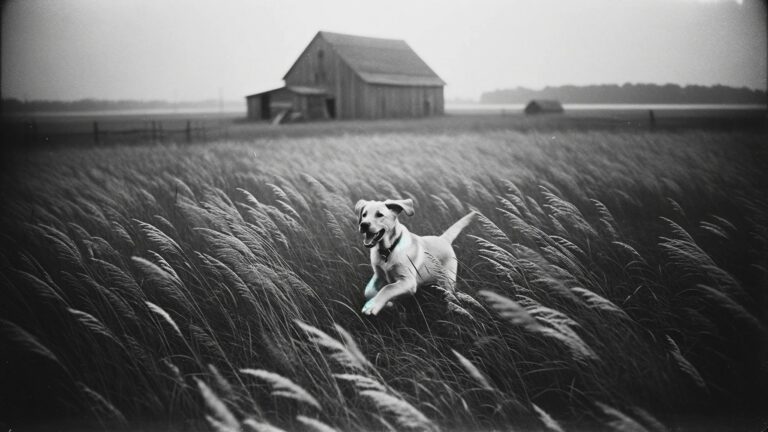Nova Scotia Duck Tolling Retriever Breed Guide: Essential Tips and Insights
The Nova Scotia Duck Tolling Retriever, often referred to as the “Toller,” is a medium-sized, energetic breed of dog originally bred for hunting waterfowl in Nova Scotia, Canada. Developed in the early 19th century, this intelligent dog combines the best characteristics of sporting and working breeds, making it a versatile and well-rounded companion. With its unique “tolling” hunting technique and its striking appearance, the Toller has gained popularity worldwide as both a working dog and an affectionate family pet.
This breed has a distinctive look, characterized by its playful and curious expression, as well as its vibrant coat, which ranges from a beautiful golden-red to a deep copper hue. Nova Scotia Duck Tolling Retrievers are known for their exceptional agility and endurance, making them a perfect fit for active families or individuals that enjoy outdoor activities. Despite their energetic nature, Tollers can adapt well to various living situations, whether that be in a city apartment or a spacious rural residence.
Key Takeaways
- The Toller is a versatile dog breed with a unique hunting technique and striking appearance.
- These dogs are energetic and agile, making them great for active families and outdoor activities.
- Nova Scotia Duck Tolling Retrievers can adapt to different living situations from city apartments to rural homes.
Breed History and Origin
Development in Nova Scotia
The Nova Scotia Duck Tolling Retriever, also known as the Toller, has its origins in the Little River Harbour area of Yarmouth County, in the Canadian province of Nova Scotia. This well-balanced breed of retriever was developed by combining various other retriever breeds and possibly some spaniel breeds. The red coated, medium-sized Toller has an intriguing breed history that is tied to its skill in hunting and luring ducks.
In the 19th and early 20th centuries, hunters in Nova Scotia desired a retriever that could not only fetch ducks from the water but also entice them within shooting range. This led to the development of the Toller breed with the unique hunting technique known as “tolling.” Through a combination of selective breeding and training, the Little River Duck Dog emerged as a specialized retriever for duck hunting, and in the process, became the foundation for the modern Nova Scotia Duck Tolling Retriever.
Original Purpose
Unlike other retrievers, the Toller’s distinctive skill lies in its ability to lure ducks towards the hunter. The breed’s playful and energetic demeanor resulted in an effective tolling technique. Tollers would play and splash near the shore, capturing the interest and curiosity of the ducks. The red coat of the Toller also played a role in enticing the ducks, as it mimicked the color of a fox – a natural predator of the ducks.
Once the ducks were lured within shooting range, the hunters would scare them into flight and shoot them down. The Toller would then jump into action, retrieving the fallen ducks from the water, and delivering them to the hunter. This dual-purpose role of tolling and retrieving made the Nova Scotia Duck Tolling Retriever a highly sought-after breed for duck hunting in its place of origin.
Over the years, the Nova Scotia Duck Tolling Retriever has retained its unique skills and qualities, marking its importance in the hunting community and allowing it to gain recognition beyond the borders of Canada. As both an intelligent, trainable companion and an effective hunting partner, the Toller has secured its place as a beloved and versatile breed among dog enthusiasts worldwide.
Physical Characteristics
Size
The Nova Scotia Duck Tolling Retriever (NSDTR) is a medium-sized dog breed. Males typically stand between 22 to 24 inches tall at the shoulder, while females are slightly shorter at 19 to 21 inches. Their weight ranges from 35 to 50 pounds, with males usually being heavier than females.
Coat
The coat of the NSDTR is a water-repellent double coat. The outer coat is medium length with a soft, dense undercoat that provides insulation in cold water. The main coat color is typically golden-red with markings of white on the chest, feet, tail, and face. Coat texture can vary from wavy to straight.
Grooming: Regular brushing, about 2-3 times a week, is important to keep the Toller’s coat healthy and prevent matting. Bathing should be done as needed.
Lifespan
The average life expectancy for a Nova Scotia Duck Tolling Retriever is around 12-14 years, which is comparable to other medium-sized dog breeds.
Distinctive Features
The NSDTR has several distinctive physical features:
- Eyes: Tollers have almond-shaped eyes that exhibit a friendly and alert expression. Eye colors range from dark brown to amber.
- Ears: The ears are triangular, medium-sized, and set high on the head, hanging close to the side of the face.
- Tail: The Toller’s tail is bushy and can be carried upward with a slight curve when the dog is in motion or alert.
- Feet: They have webbed feet, which aid in swimming and retrieving in water.
- Head & Body: The breed’s head is wedge-shaped, with a moderate stop and well-defined muzzle. Their body is compact and well-proportioned, with a deep chest and muscular limbs that enable them to be agile and energetic while working in the field.
The combination of these characteristics gives the Nova Scotia Duck Tolling Retriever its unique and recognizable appearance, making it stand out among other retriever breeds.
Temperament and Personality
| Behavior/Trait | Description | Ideal For |
| Energy Level | High | Active families or individuals |
| Trainability | Highly trainable | Obedience and agility training |
| Socialization | Friendly and sociable | Families with children and other pets |
General Disposition
Nova Scotia Duck Tolling Retrievers (Tollers) are known for their intelligent and affectionate nature. They are friendly, outgoing, and possess a curious temperament. These dogs have high-energy levels and are always eager to please their owners.
Tollers are also alert and aware of their surroundings, which makes them excellent watchdogs. They thrive on being part of a family and often display strong bonds with their human companions.
Behavior
Tollers have a playful and energetic demeanor that requires regular physical and mental stimulation. This breed enjoys participating in various dog sports, such as agility or obedience competitions, and excels in retrieving games. They are best suited for active families or individuals who can provide the time and energy required to keep them healthy and happy.
In regards to interactions with children, other pets, and strangers, Nova Scotia Duck Tolling Retrievers are generally sociable and gentle. They tend to get along well with children, given proper training and supervision.
Tollers can also coexist peacefully with other pets but might display a prey-drive when encountering smaller animals, such as birds or rodents. Early socialization with a variety of people and animals is key in helping them become well-rounded dogs.
Trainability
The intelligent nature of Nova Scotia Duck Tolling Retrievers makes them highly trainable. They respond well to positive reinforcement methods, such as clicker training or rewards-based techniques. This breed appreciates a consistent and firm approach from their trainer, coupled with patience and understanding.
Tollers enjoy problem-solving and engaging in mentally stimulating activities. Ensuring that training sessions are varied and fun can help keep them motivated and invested in learning. Due to their alertness and eagerness to please, these dogs often excel in advanced obedience and various dog sports.
Overall, the temperament and personality of Nova Scotia Duck Tolling Retrievers make them a popular and versatile breed. Being provided with the right guidance, training, and care, Tollers are adaptable and can become loyal companions and impressive sporting partners.
Health and Wellness
Common Health Issues
Nova Scotia Duck Tolling Retrievers are generally a healthy breed, but like all dogs, they can be prone to certain health problems. Some of the common issues include degenerative myelopathy, hip dysplasia, progressive retinal atrophy, and immune-mediated diseases, with some Tollers also showing signs of a systemic rheumatic disorder.
Health Screenings
To ensure the best possible health for a Nova Scotia Duck Tolling Retriever, it is best to conduct regular health screenings. Recommended tests include hip and elbow evaluations, eye examination, and genetic testing for degenerative myelopathy. These tests can help identify any potential health issues early, allowing for necessary preventative measures or treatment.
Diet and Nutrition
A well-balanced diet is significant for maintaining the overall health and well-being of a Nova Scotia Duck Tolling Retriever. They should be fed high-quality dog food suitable for their age, size, and activity level. The breed’s diet should be carefully monitored to prevent overfeeding and obesity, as this can lead to health problems down the line. A veterinarian can recommend the best feeding guidelines and help in selecting the appropriate food.
Exercise Needs
Nova Scotia Duck Tolling Retrievers are energetic and athletic dogs, requiring regular exercise to maintain their physical and mental health. They have excellent endurance and enjoy activities such as swimming, fetching, and hiking. The breed thrives on at least one hour of exercise per day, including mental stimulation through training or games. It’s essential to meet their exercise needs to keep them happy, healthy, and well-behaved.
Training and Behavior
Early Socialization
Nova Scotia Duck Tolling Retrievers, also known as NSDTRs or simply “Tollers,” are a medium-sized purebred dog breed recognized by the AKC and Canadian Kennel Club. As with any dog breed, early socialization is essential for developing well-rounded and confident dogs. Socializing puppies from a young age exposes them to different people, environments, and other animals, helping them become more adaptable and resilient.
One of the key aspects of socialization for Tollers is introducing them to various situations where they can practice their natural retrieving instincts. These dogs were bred for their unique retrieving ability, making it important to nurture this skill from an early age. To promote socialization, expose your Toller to different environments, such as parks, and introduce them to various fetching games that can help develop their retrieving skills.
Training Techniques
Nova Scotia Duck Tolling Retrievers are intelligent and eager to please, making obedience training a smoother process. It’s a good thing to use positive reinforcement techniques, such as praise, treats, or playtime to reward good behavior. This approach will help develop a strong bond between you and your Toller and promote a better response to training sessions.
One of the challenges with training Tollers can be their high prey drive. This breed is known for their hunting instincts, and they may get easily distracted by potential prey, like small animals or birds. To help your Toller manage this instinct, incorporate impulse control exercises into training sessions, such as teaching them the “leave it” or “stay” commands.
Consistency and patience are needed to help your Toller overcome their natural tendencies and focus on training.
Behavioral Challenges
Despite their friendly nature, Tollers may exhibit some behavioral issues that owners should be aware of. One potential challenge is excessive vocalization, as these dogs can be quite talkative. To address this issue, consider redirecting your Toller’s energy into productive activities like fetch or offering puzzle toys that mentally stimulate them.
Another common issue among Tollers is separation anxiety. These dogs form strong bonds with their families and may struggle when left alone for extended periods. Gradually increasing the amount of time your Toller spends alone, using crate training, or implementing a consistent daily routine can help alleviate these feelings of anxiety.
Working and Activities
Historical Role
The Nova Scotia Duck Tolling Retriever (NSDTR) has a long history as a hunting companion. Originally bred in Canada, this medium-sized gundog was specifically designed to lure ducks within a hunter’s gunshot range.
Their unique tolling behavior, which involves frolicking and playful movements near the water’s edge, piques the curiosity of waterfowl and encourages them to swim closer. Once the ducks are within range, the NSDTR acts as a skilled retriever, collecting the fallen birds from the water and returning them to the hunter.
Modern Roles
Today, the Nova Scotia Duck Tolling Retriever remains a popular breed for hunting enthusiasts, but it has also found success in various dog sports and activities. Their agility, intelligence, and strong work ethic make them well-suited for competitions such as obedience, tracking, and flyball. Additionally, their natural retrieving abilities have led to their participation in search and rescue efforts.
The breed has also made a name for itself in the show ring, where their distinctive appearance and animated personalities make them crowd favorites. While their historical role as a gundog is still relevant, the versatile NSDTR has adapted well to modern roles.
Mental and Physical Stimulation
Nova Scotia Duck Tolling Retrievers require both mental and physical stimulation to stay happy, healthy, and engaged. These dogs thrive when given tasks to perform, such as participating in training exercises or practicing their tolling techniques. Regular exposure to a variety of challenges and environments helps to keep their minds sharp and focused.
To meet their energy demands, daily exercise is essential. Long walks, runs, and interactive play sessions offer opportunities for physical exertion, while mentally stimulating games like puzzle toys or scent work can be equally fulfilling.
For owners seeking new activities or bonding experiences with their NSDTR, exploring dog sports like agility or dock diving can provide exciting challenges and opportunities to showcase the breed’s natural talents. In any setting, it is necessary to prioritize the Toller’s mental and physical well-being to ensure a balanced and content dog.
Care and Grooming
Coat Care
The Nova Scotia Duck Tolling Retriever has a water-repellent double coat consisting of a soft undercoat and a medium-length, straight topcoat. Regular grooming helps maintain the natural oils in their skin and ensures their coat stays healthy.
Brush your Toller’s coat at least once a week using a slicker brush or a pin brush to remove loose hairs, minimize shedding, and prevent matting. Since their coat is water-repellent, bathe them only when necessary to avoid stripping away the natural oils.
Ear, Teeth, and Nail Care
Like most breeds, the Nova Scotia Duck Tolling Retriever requires regular ear, teeth, and nail care. Clean their ears using a dog-safe ear cleaner and cotton balls to prevent infections. Check their ears weekly for signs of redness or inflammation.
To maintain good oral hygiene, brush your Toller’s teeth two to three times a week using a dog-friendly toothpaste and toothbrush. This helps prevent dental issues like tartar buildup and gum disease.
Lastly, trim their nails every three to four weeks to avoid discomfort during movement or exercise. Be cautious while clipping their nails to avoid cutting the quick, which may lead to pain and bleeding.
Shedding
Tollers shed moderately throughout the year, with heavier shedding during seasonal changes when they lose their undercoat. To manage shedding, increase the frequency of grooming sessions – brushing their coat daily using an undercoat rake or shedding tool helps remove loose hairs effectively. This ensures that your home stays relatively fur-free, and your Toller’s coat remains healthy.
By following these care and grooming guidelines, you can keep your Nova Scotia Duck Tolling Retriever looking clean and feeling comfortable while also ensuring their coat, ears, teeth, and nails are well-maintained.
Living Conditions
Housing
Nova Scotia Duck Tolling Retrievers (NSDTR) are adaptable dogs that can adjust to various housing situations. They can thrive in both apartments and houses as long as their exercise needs are met. However, these dogs are energetic and active, which makes having a yard or open space highly beneficial.
If you have children, the NSDTR breed is a great choice. They are friendly, patient, and gentle with kids, making them wonderful family companions. With proper socialization and training, these retrievers tend to get along well with other pets in the household.
Outdoor Needs
Due to their high energy levels and working heritage, Nova Scotia Duck Tolling Retrievers require plenty of outdoor activities to stay physically and mentally healthy. They do best in homes with access to a yard or open spaces, as it allows them to play, run, and release energy. Regular walks, runs, and playtime with other dogs are encouraged to keep them happy and well-adjusted.
Exercise requirements:
- Daily long walks or runs
- Plenty of playtime with toys or fetch games
- Off-leash activities in enclosed areas
- Mental stimulation through training and puzzles
Climate Considerations
Nova Scotia Duck Tolling Retrievers have a double coat that is water-repellent and helps protect them against different weather conditions. They can tolerate both cold and warm climates, but it is required to take necessary precautions.
In cold weather, their thick undercoat provides insulation to withstand low temperatures. However, owners should still be cautious of extreme cold and provide shelter or warmth when needed.
In warmer climates, make sure that your NSDTR has access to fresh water, shade, and opportunities to cool down. Avoid exercising during the hottest parts of the day and watch for signs of overheating, such as excessive panting or drooling.
To maintain their coat and mitigate the effects of weather, regular grooming is essential. Their coats should be brushed weekly, and during shedding, they may need more frequent grooming sessions.
Overall, Nova Scotia Duck Tolling Retrievers are adaptable and versatile dogs, but their living conditions should cater to their exercise needs, provide proper shelter, and consider the specific climate.
Adoption and Purchase
Considerations
Before getting a Nova Scotia Duck Tolling Retriever, it’s essential to understand the breed’s specific needs and characteristics. Tollers are intelligent, energetic, and require daily physical and mental stimulation. They were bred to be working dogs, so they excel in activities like agility, obedience, and retrieval.
Potential adopters should be prepared to provide them with ample exercise and training opportunities. It’s also wise to familiarize yourself with the breed standard to ensure you choose a healthy, well-bred dog.
Reputable Breeders
When looking to purchase a Toller from a breeder, it’s required to recognize and choose a good one. A reputable breeder should prioritize the health and genetic testing of their breeding stock, provide proper socialization for their puppies, and be willing to answer any questions or concerns you may have. They should also provide a written contract and health guarantee for their puppies.
Rescue Organizations
For those interested in adopting a Nova Scotia Duck Tolling Retriever, breed-specific rescue organizations can be a valuable resource. These organizations often have Tollers available for adoption, who may have been surrendered, abandoned, or rescued from unfavorable conditions.
Adoption processes usually involve submitting an application, going through a home visit, and meeting available Tollers to find the best fit for your family. Adopting from a rescue organization not only provides a second chance for the dog but can also be a more affordable option compared to purchasing from a breeder.
Bear in mind that rescue organizations sometimes have thorough adoption procedures to ensure the best possible match for both the dog and the adopting family. It’s necessary to be patient and open-minded throughout the process, as the main goal is to find a loving, suitable home for the Toller in need.
Fun Facts and Trivia
Unique Characteristics
The Nova Scotia Duck Tolling Retriever, often referred to as “Tollers,” is a medium-sized, compact, and powerful dog breed known for its energetic and playful nature. This breed shares some similarities with the Golden Retriever but possesses unique features that make it stand out. Most notably, Tollers often have distinctive white markings on their chest, face, and paws.
Tollers are great swimmers, making them excellent companions for waterfowl hunting. Their unique technique involves using a stick to play on the water’s edge, sparking the curiosity of nearby ducks or geese. The hunter can then easily retrieve the birds once they are within range.
An interesting tidbit about the breed is its fox-like expression, which results from the shape of their skull, nose, lips, and bite. This gives them a lively appearance that can be both endearing and captivating.
Famous Tollers
While not as well known as the Golden Retriever or other popular breeds, the Nova Scotia Duck Tolling Retriever has gained some fame in various ways. A few famous Tollers have made their mark on the world, being owned by notable individuals or appearing in media.
One example is a Toller named Harbourlights Nifty Duke who appeared in the 1996 film, “The Boys’ Club,” showcasing the breed’s agility and intelligence. Another notable Toller is Can Ch Westerlea’s Tru Ray Red Rebel, who was a breed champion and known for his exceptional appearance, character, and hunting abilities.
This breed’s unique characteristics, fascinating history, and ability to excel in various activities make the Nova Scotia Duck Tolling Retriever an intriguing breed to explore further. Whether they are chasing ducks on the water or charming people with their fox-like expressions, Tollers are a breed that never fails to impress.
Frequently Asked Questions
What is the lifespan of a Nova Scotia Duck Tolling Retriever?
Nova Scotia Duck Tolling Retrievers typically have a lifespan of 12 to 14 years. Like any breed, they can be prone to certain health issues, but with regular veterinary checkups and proper care, these dogs can lead long, healthy lives.
What are the typical personality traits of a Nova Scotia Duck Tolling Retriever?
The Nova Scotia Duck Tolling Retriever (NSDTR) is known for its intelligent, energetic, and playful nature. These dogs form strong bonds with their families and are often friendly towards other dogs and pets. They are also highly trainable, which makes them suitable for various activities, such as obedience training and dog sports.
What are the common coat colors for Nova Scotia Duck Tolling Retrievers?
Nova Scotia Duck Tolling Retrievers have a distinctively colored coat, which ranges from a deep copper-red to a golden-orange hue. Some dogs may have white markings on their face, chest, paws, and tail tip. The Tollers’ coat is medium-length, straight or wavy, and water-repellent, making it suitable for their work as hunting dogs near water.
Where can I find Nova Scotia Duck Tolling Retriever puppies for adoption or purchase?
When searching for a Nova Scotia Duck Tolling Retriever puppy, it is a must to work with reputable breeders or consider adopting from a rescue organization. You can find breeders through the national breed club or by attending local dog shows. Reach out to rescues and shelters specializing in the breed or mixed breeds to find available Tollers for adoption.
What is a Nova Scotia Duck Tolling Retriever and Poodle mix called?
A mix between a Nova Scotia Duck Tolling Retriever and a Poodle is commonly referred to as a “Toller Doodle” or “TollerPoo.” These hybrid dogs often inherit the intelligence, energy, and trainability of both breeds. Their coat may vary in length and texture, but it’s typically low-shedding, thanks to the Poodle lineage.
As with any mixed breed, remember that every individual dog’s traits and temperament may differ depending on the specific genetics inherited from each parent.







